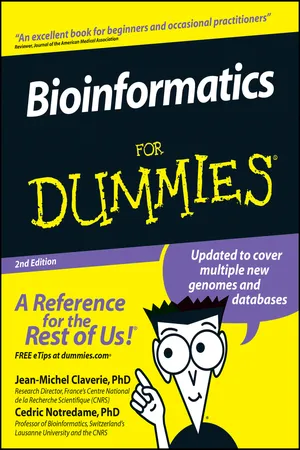
- English
- ePUB (mobile friendly)
- Available on iOS & Android
Bioinformatics For Dummies
About this book
Were you always curious about biology but were afraid to sit through long hours of dense reading? Did you like the subject when you were in high school but had other plans after you graduated? Now you can explore the human genome and analyze DNA without ever leaving your desktop!
Bioinformatics For Dummies is packed with valuable information that introduces you to this exciting new discipline. This easy-to-follow guide leads you step by step through every bioinformatics task that can be done over the Internet. Forget long equations, computer-geek gibberish, and installing bulky programs that slow down your computer. You'll be amazed at all the things you can accomplish just by logging on and following these trusty directions. You get the tools you need to:
- Analyze all types of sequences
- Use all types of databases
- Work with DNA and protein sequences
- Conduct similarity searches
- Build a multiple sequence alignment
- Edit and publish alignments
- Visualize protein 3-D structures
- Construct phylogenetic trees
This up-to-date second edition includes newly created and popular databases and Internet programs as well as multiple new genomes. It provides tips for using servers and places to seek resources to find out about what's going on in the bioinformatics world. Bioinformatics For Dummies will show you how to get the most out of your PC and the right Web tools so you'll be searching databases and analyzing sequences like a pro!
Frequently asked questions
- Essential is ideal for learners and professionals who enjoy exploring a wide range of subjects. Access the Essential Library with 800,000+ trusted titles and best-sellers across business, personal growth, and the humanities. Includes unlimited reading time and Standard Read Aloud voice.
- Complete: Perfect for advanced learners and researchers needing full, unrestricted access. Unlock 1.4M+ books across hundreds of subjects, including academic and specialized titles. The Complete Plan also includes advanced features like Premium Read Aloud and Research Assistant.
Please note we cannot support devices running on iOS 13 and Android 7 or earlier. Learn more about using the app.
Information
Part I
Getting Started in Bioinformatics

Chapter 1
Finding Out What Bioinformatics Can Do for You
In This Chapter



What Is Bioinformatics?
Analyzing Protein Sequences
Table of contents
- Title
- Contents
- Introduction
- Part I : Getting Started in Bioinformatics
- Part II : A Survival Guide to Bioinformatics
- Part III : Becoming a Pro in Sequence Analysis
- Part IV : Becoming a Specialist: Advanced Bioinformatics Techniques
- Part V : The Part of Tens